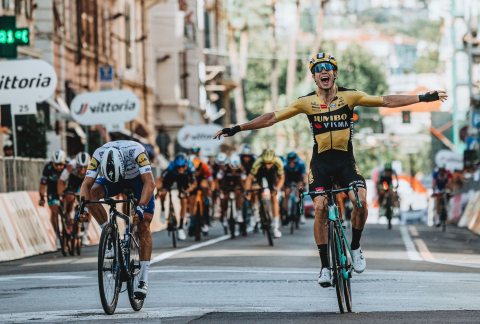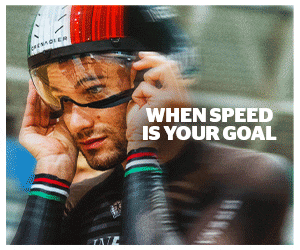Over the past twenty years, the Poggio was becoming less and less decisive. Since the turn of the century, a sprinter has triumphed on the Via Roma no less than eleven times. But in the last four years the turnaround has come thanks to Kwiatkowski, Nibali, Alaphilippe and Van Aert.
 |
Milan San Remo – The Poggio (from wielerflits)
Over the past twenty years, the Poggio was becoming less and less decisive. Since the turn of the century, a sprinter has triumphed on the Via Roma no less than eleven times. But in the last four years the turnaround has come thanks to Kwiatkowski, Nibali, Alaphilippe and Van Aert.
It was in the late 1950s when the organizers of Milan-San Remo discovered the Poggio, after which the famous bulge was first added to the route of the Classic in 1960. Since then, the peloton has been racing continuously up the Poggio for more than half a century. A short four kilometers with barely 149 meters difference in height and an average gradient of 3.7 percent. No more than a molehill for a professional, but enough after 180 miles to separate the men from the boys.
In the following decades after the 1950s, icons of the sport like Poulidor, Merckx, and Raas, among others, laid the foundation for their success on the Primavera. If no difference was made there on the ascent, there was still the technical descent to be used to make the difference. Merckx rode away from his rivals on that descent in both 1969 and 1972. De Vlaeminck, Moser and Kelly later followed his example.
With sprinters such as Zabel, Cipollini, Freire, Petacchi, Cavendish, Ciolek, Kristoff, Degenkolb and Démare, the last twenty years have mainly been sprinters contesting the party on the Via Roma. Cancellara made his move in the streets of San Remo in 2008 with a late and surprise attack. Only Bettini (2003, won the sprint of a trio), Pozzato (2006, survivor of a group that left the Poggio), Goss (2011, the fastest of eight), Simon Gerrans (2012, together with Cancellara and Nibali) and Gerald Ciolek (2013, together with Sagan the only sprinter to survive the climb) laid the basis for their victory on the Poggio. After Ciolek, there was again three years in a row where a large group sprinted on the Via Roma.
But the past four editions Kwiatkowski, Nibali, Alaphilippe (in 2019 with six others in his wake, last year with Van Aert) proved that an attack on the Poggio (literally translated: ‘the small hill’) can still pay off. In 2017, Peter Sagan continued with Julian Alaphilippe and Michal Kwiatkowski, after which the latter beat his two fellow escapees in the sprint. In 2018, Vincenzo Nibali slipped away, only to keep the chasing peloton behind him after a lightning-fast descent. Alaphilippe attacked in 2019, with six other riders in his wake. And in 2020, the Frenchman shot away again. Only Wout van Aert could keep up with him on the descent and beat him in the sprint.
Photo: The Roadbook 2020
Since the introduction of the Poggio, Milan-San Remo has been contested 58 times. Where was the foundation of victory laid? An overview of the last 20 years:
ON THE CLIMB: x 9
2003: Paolo Bettini, 2006: Filippo Pozzato, 2011: Matthew Goss, 2012: Simon Gerrans, 2013: Gerald Ciolek, 2017: Michal Kwiatkowski, 2018: Vincenzo Nibali, 2019: Julian Alaphilippe, 2020: Wout van Aert
IN THE STREETS OF SAN REMO: 1 x
2008: Fabian Cancellara
IN A GROUP PRINT: x 10 x (group size in brackets)
2001: Erik Zabel (60),
2002: Mario Cipollini (44),
2004: Oscar Freire (28),
2005: Alessandro Petacchi (39),
2007: Oscar Freire (46),
2009: Mark Cavendish (34),
2010: Oscar Freire (25),
2014: Alexander Kristoff (27),
2015: John Degenkolb (26),
2016: Arnaud Demare (31)
Source Click here for the original article in Dutch:
Cycle Division’s Shop
Send your results as well as club, team & event news here
Other Results on VeloUK (including reports containing results)
- Features, Reports, Results
- Result: Beverley Town Centre Races
- Hill Climb Championships: Change of Course
- Crit Result: Portsmouth Evening Circuits 11
- Crit Result: RCR FatCreations Goodwood Summer Special
- UK Armed Forces Inter-services Road Race
- Report: TLI Cycling ‘Belgium Training Series
- BMCR RESULT: The Ron Day MK Bowl Circuit races (July 23rd)
- RR Result: Bath RC Junior National Series Road Race
- Crit Result: West Thames League 15
- Crit Result: SACA Salt Ayre Tuesday Series 15
- Crit Result: Bath CC Mid Summer Series 2
- Crit Result: Full Gas Summer Circuit Series #17
- TT Result: Ross-On-Wye & Dist CC 25m TT
- TT Result: Ross-On-Wye & Dist CC 10m TT
- TT Result: Kernow Racing Team 10m TT
- News: Men’s Tour of Britain Route (Stage 1 & 2)
- Youth Result: RL360 Isle of Man Youth League 14
- TT Result: Verulam Cycling Club 25m TT
- TT Result: Manchester & District Ladies CA 25m TT
- TT Result: Ferryhill Wheelers CC 25m TT
- Crit Result: Banbury Star Crit Series #2
- RR Result: Lakes Road Club Summer Road Race
- National Circuit Series: Colne
- TT Result: Kings Lynn CC 15m TT
- TT Result: ECCA 10 mile Time Trial
- TT Result: Chorley Cycling Club 10m TT
- TT Result: Houghton CC 25m TT
- TT Result: Bournemouth Jubilee Wheelers 10m TT
- TT Result: Farnham RC 10m TT
- Crit Result: King&Queen of the Bowl Series #13
- TT Result: Kernow Racing Team 10m TT
- Crit Result: Lichfield/Velospeed No Frills at Curborough #7
- TT Result: Swindon RC & Swindon Wh 50m TT
- Crit News: Spatzwear Friday Night Crit Series #6 | YBC
- GB News: Paracycling Squad for Paris 2024
- Crit Result: Thanks Crit it’s Friday 7
- Crit Result: Omega Portsmouth Circuits 6
- Result: BMCR National Road Bike TT Championship
- Crit Result: Ride Revolution Coaching Summer Crits #2
- Crit Result: Shutt Velo Rapide Hitters Crits Rd2
Other News on VeloUK
- Hill Climb Championships: Change of Course
- TT Result: Ross-On-Wye & Dist CC 25m TT
- News: Men’s Tour of Britain Route (Stage 1 & 2)
- GB News: Paracycling Squad for Paris 2024
- Ribble Redefines Road with launch of Allroad
- BMCR: National Road Bike Time Trial Championship
- SUNDAY: Bath Road Club Junior National Series Road Race
- TLI CYCLING FEATURE: SUPER4SERIES
- NATIONAL CIRCUIT SERIES UPDATE 2024
- News: Josh Tarling Extends Contract at Ineos
- Tour of Britain for Men 2024
- News: Connor Swift Extends Contract with Ineos
- Updated GB Olympic Team News
- Sunday: 2024 Youth Circuit Race Championships (Cyclopark)
- ROBBED BY THE HIGHWAYS AGENCY – National Highways
- Startlist: BMCR National Road Championships E/F/G/H
- OLYMPIC NEWS – Team GB Announces First Riders for Olympics
- News: Alex Richardson Retires
- New Releases from Shutt Velo Rapide
- STARTLIST: Men’s British Road Race Championships
- STARTLIST: 2024 Women’s British Road Race Championships
- Startlist: 2024 CAMS Yorkshire Classic Road Races
- Startlists: 2024 Circuit Race Championships
- Startlist: CAMS Ronde van Wymeswold
- Startlists & 2023 Results: National Time Trial Championships
- NEWS: Star Studded Line Up for National Road Champs
- Riders so far: London Dynamo Summer Road Races
- Women’s Tour of Britain Startlist (provisional)
- News: Lincoln winner hit by car
- Entries Wanted: Ilkley Cycles Races
- GB Team Named for Women’s Tour of Britain
- STARTLISTS: NW, Yorkshire & NE Regional RR Championships
- Startlists: East Midlands Road Race Championships
- News: Ribble Rebellion Race USA’s Armed Forces Cycling Classic
- TT Result: Legato Racing Team 10m TT
- Pre-Race Rider Quotes: Ford RideLondon Classique
- STARTLIST: Witham Wheelers Road Races
- Team News: Tour of Britain for Alba Development RT
- Startlist: Totnes Vire 2024
- Starters: NW Junior/U23 360cycling Two Day




















